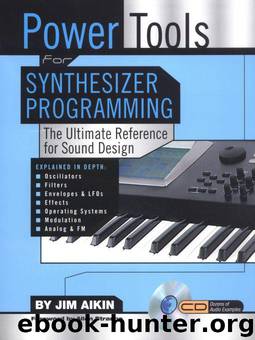Power Tools for Synthesizer Programming: The Ultimate Reference for Sound Design (Power Tools Series) by Aikin Jim

Author:Aikin, Jim [Aikin, Jim]
Language: eng
Format: epub
Publisher: Backbeat Books
Published: 2004-01-01T05:00:00+00:00
Many instruments allow keyboard tracking to be set to negative as well as positive amounts. This is useful in a few situations, such as programming keyboard crossfades. With a negative keyboard tracking amount, the filter can be programmed so that low notes sound quite bright while high notes are inaudible because the fundamental and all of the overtones are in the stop-band. Most of the time, though, keyboard tracking amounts between 0 and 100% will give you what you need.
Envelope Modulation. Changing the filter cutoff frequency in a controlled way during the course of each note is a basic technique for giving shape to the notes coming from your synth. This is accomplished by using an envelope to modulate the cutoff. (For details on envelope generators, see Chapter Seven.) Because each synth voice has its own envelope(s) and filter(s), each note will be shaped separately by the filter envelope.
Some synths have dedicated filter envelopes. Others provide general-purpose envelopes, whose output can be used to modulate the filter or other modules. Most synths provide, as well, a way to invert the envelope being applied to the filter. This may be accomplished with an invert button in the envelope, or with a bidirectional modulation amount knob in the filter itself. When the envelope is inverted, the filter cutoff will drop as the envelope rises, and vice-versa.
The classic form of envelope modulation, beloved of electronic musicians everywhere, is to program the filter envelope with an instant attack, a short to medium decay, and zero sustain (see Project 5-2, at the end of this chapter). This patch can produce quick filter “blips” on the attack of a bass sound, a long sighing decay on a sustained chord, or anything in between.
Velocity Modulation. As noted above, acoustic instruments typically sound brighter as well as louder when they’re struck, bowed, or blown harder. In synthesizers, this effect is duplicated by modulating the filter cutoff with MIDI velocity. Notes played with higher velocities will raise the cutoff of a lowpass filter higher, thus allowing more overtones to pass through the filter. To find the right balance between velocity control of the filter and velocity control of amplitude, you’ll need to be sensitive to sound and knowledgeable about the capabilities of your synth.
As explained in Chapter Seven, in the section “Modulating the Envelope,” velocity modulation applied directly to the filter cutoff has a somewhat different effect from velocity modulation applied to the filter envelope amount. Velocity modulation of the filter envelope time parameters, especially decay time, will also have a big effect on the character of your filtered sounds.
Modulation in Performance. Most MIDI synthesizers provide some way to control filter cutoff from MIDI. You may also be able to control filter cutoff from your synth’s left-hand controller section. Recording a filter sweep into a MIDI sequencer as controller data is a classic technique for giving a shape to an entire phrase. The first notes in the phrase might be quite muted, notes in mid-phrase bright, and notes at the end muted once more.
Download
This site does not store any files on its server. We only index and link to content provided by other sites. Please contact the content providers to delete copyright contents if any and email us, we'll remove relevant links or contents immediately.
The Goal (Off-Campus #4) by Elle Kennedy(13543)
Kathy Andrews Collection by Kathy Andrews(11730)
Diary of a Player by Brad Paisley(7487)
What Does This Button Do? by Bruce Dickinson(6135)
Assassin’s Fate by Robin Hobb(6131)
Big Little Lies by Liane Moriarty(5702)
Altered Sensations by David Pantalony(5045)
Pale Blue Dot by Carl Sagan(4912)
Sticky Fingers by Joe Hagan(4101)
The Death of the Heart by Elizabeth Bowen(3552)
The Heroin Diaries by Nikki Sixx(3494)
Beneath These Shadows by Meghan March(3262)
Confessions of a Video Vixen by Karrine Steffans(3246)
How Music Works by David Byrne(3187)
The Help by Kathryn Stockett(3083)
Jam by Jam (epub)(3024)
Harry Potter 4 - Harry Potter and The Goblet of Fire by J.K.Rowling(2990)
Strange Fascination: David Bowie: The Definitive Story by David Buckley(2799)
Petty: The Biography by Warren Zanes(2697)
